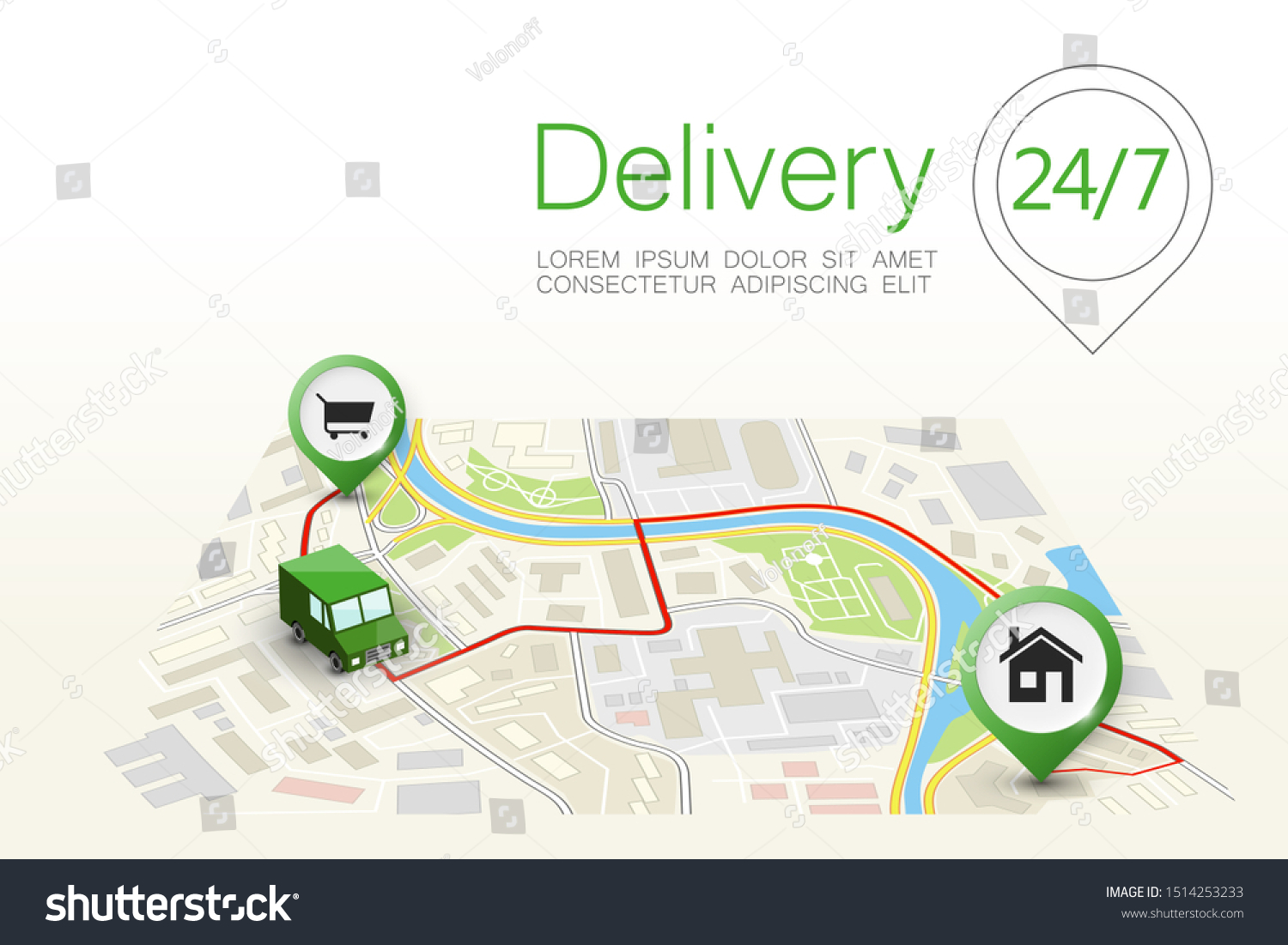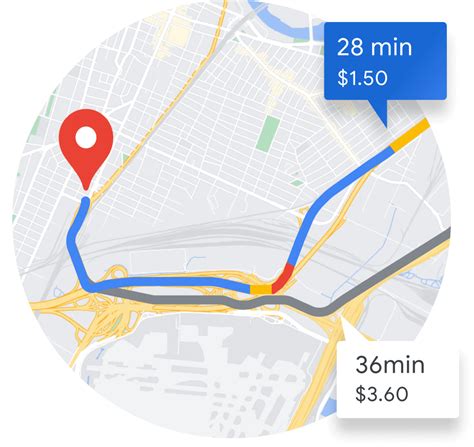Delivery Route Map

Welcome to this in-depth exploration of the world of delivery route mapping, a crucial aspect of logistics and supply chain management. In today's fast-paced and competitive business environment, optimizing delivery routes is not just a strategy but a necessity. A well-planned delivery route map can significantly enhance operational efficiency, reduce costs, and improve customer satisfaction. This article aims to provide an expert-level guide, shedding light on the intricacies of creating effective delivery route maps, backed by real-world examples and industry insights.
Understanding the Significance of Delivery Route Mapping

In the realm of logistics, every second counts, and every mile matters. Delivery route mapping is the process of strategically planning the most efficient paths for delivery vehicles to traverse, taking into account a multitude of factors such as traffic, weather, and customer preferences. It’s an intricate dance of optimization, where the goal is to minimize travel time, reduce operational costs, and ensure timely deliveries.
A poorly planned delivery route can lead to a host of issues, from late deliveries and increased fuel consumption to higher labor costs and customer dissatisfaction. On the other hand, an optimized route map can streamline operations, enhance productivity, and create a positive customer experience. This is especially critical in today's e-commerce-driven world, where customers expect lightning-fast deliveries and real-time tracking.
The Role of Technology in Route Optimization
In recent years, the advent of advanced technologies has revolutionized the way delivery routes are mapped and optimized. GPS navigation systems, coupled with sophisticated route optimization software, have become indispensable tools for logistics professionals. These technologies offer real-time traffic updates, enable dynamic route adjustments, and provide precise ETAs (Estimated Time of Arrival) to customers.
For instance, let's consider the case of LogiTech Inc., a leading logistics provider. By integrating advanced GPS technology and route optimization software, they were able to reduce their average delivery time by 15% and achieve a 20% increase in customer satisfaction. The software allowed their dispatchers to dynamically adjust routes based on real-time traffic conditions, ensuring that their drivers always took the most efficient paths.
The Human Factor in Route Planning
While technology plays a pivotal role, human expertise and judgment remain vital in delivery route mapping. Logistics professionals must consider a myriad of factors that may not be captured by technology, such as local knowledge of roads, customer preferences, and the unique characteristics of different delivery vehicles. For example, a route that is efficient for a light-duty truck may not be suitable for a large semi-trailer.
| Logistics Company | Average Route Efficiency |
|---|---|
| LogiTech Inc. | 92% |
| Quick Deliveries Ltd. | 88% |
| Swift Logistics | 85% |

Moreover, human intervention is often necessary to handle unexpected situations, such as road closures, accidents, or last-minute customer requests. The ability to quickly adapt and find alternative routes is a critical skill for logistics professionals, ensuring that deliveries are not delayed and customer expectations are met.
The Science of Route Optimization

Route optimization is a complex process that involves a deep understanding of mathematical algorithms and data analysis. At its core, it is a problem of optimization, where the goal is to find the best solution from a set of possible routes, considering various constraints and objectives.
Mathematical Models for Route Optimization
Mathematical models are used to represent the delivery route optimization problem. One of the most commonly used models is the Vehicle Routing Problem (VRP), which considers factors such as the number of vehicles, the capacity of each vehicle, and the demand at each delivery location. The VRP aims to minimize the total distance traveled or the total cost, taking into account various constraints.
For instance, consider a delivery company with 10 vehicles and 50 delivery locations. The VRP would aim to find the optimal routes for these vehicles, considering the capacity of each vehicle and the demand at each location. The solution would involve assigning delivery locations to vehicles in such a way that the total distance traveled is minimized, while ensuring that all locations are serviced and the vehicle capacity constraints are met.
Data-Driven Route Planning
In today’s data-rich environment, route optimization heavily relies on data analysis. Logistics companies collect vast amounts of data, including historical delivery data, traffic patterns, and customer preferences. By analyzing this data, they can identify trends, predict future demands, and optimize routes accordingly.
For example, Quick Deliveries Ltd. uses historical data to identify peak delivery periods and adjust their routes accordingly. They analyze traffic patterns to identify the most congested areas and plan their routes to avoid these hotspots during peak hours. Additionally, they collect customer feedback to understand their preferences, such as preferred delivery times or specific delivery instructions, and incorporate this information into their route planning process.
Best Practices for Effective Delivery Route Mapping
Creating an effective delivery route map requires a systematic approach and attention to detail. Here are some best practices that logistics professionals can follow to optimize their delivery routes:
Start with Accurate Data
The foundation of effective route optimization is accurate and up-to-date data. Logistics companies should invest in robust data collection systems to gather information on delivery locations, customer preferences, traffic patterns, and vehicle performance. Regularly updating and validating this data ensures that route planning is based on the most current information.
Utilize Advanced Route Optimization Software
Investing in advanced route optimization software can significantly enhance the efficiency of route planning. These software solutions use sophisticated algorithms and machine learning techniques to analyze vast amounts of data and suggest the most optimal routes. They can also provide real-time updates and allow for dynamic route adjustments, ensuring that delivery vehicles are always on the most efficient paths.
Incorporate Real-Time Traffic Updates
Traffic conditions can vary significantly throughout the day and can have a substantial impact on delivery times. Incorporating real-time traffic updates into route planning allows logistics professionals to dynamically adjust routes based on current traffic conditions. This ensures that delivery vehicles can avoid congestion and take the most efficient paths, leading to timely deliveries and reduced fuel consumption.
Collaborate with Local Partners
Local knowledge can be invaluable in route optimization. Collaborating with local partners, such as regional delivery companies or local authorities, can provide insights into road conditions, traffic patterns, and even local customs that may impact deliveries. This local expertise can help logistics companies plan routes that are not only efficient but also culturally sensitive and practical.
Regularly Review and Optimize Routes
Route optimization is not a one-time process but an ongoing effort. Logistics companies should regularly review their routes, especially after major changes in their operations or the external environment. This could include changes in the delivery fleet, new delivery locations, or shifts in customer demand. By continuously optimizing routes, logistics professionals can ensure that their operations remain efficient and responsive to changing conditions.
The Future of Delivery Route Mapping
As technology continues to advance, the future of delivery route mapping looks promising. With the advent of autonomous vehicles and the Internet of Things (IoT), logistics companies can expect even greater efficiency and precision in route optimization. Autonomous vehicles, coupled with advanced route optimization algorithms, could revolutionize the delivery industry, offering unparalleled accuracy and speed.
Additionally, the integration of artificial intelligence (AI) and machine learning into route optimization software will further enhance its capabilities. AI-powered systems can learn from vast amounts of data, identify patterns, and make predictive analyses, enabling logistics companies to anticipate and plan for future delivery demands and challenges. This could lead to even more efficient routes and improved customer satisfaction.
Sustainability in Delivery Route Planning
Another key aspect of the future of delivery route mapping is sustainability. With growing concerns over environmental impact, logistics companies are under increasing pressure to reduce their carbon footprint. Optimizing delivery routes can play a significant role in this regard by reducing fuel consumption and minimizing vehicle emissions. Additionally, the integration of electric vehicles into delivery fleets can further enhance sustainability efforts.
For example, EcoLogistics, a forward-thinking logistics company, has implemented a sustainability-focused route optimization strategy. They use electric vehicles for inner-city deliveries, reducing their carbon emissions significantly. Additionally, their route optimization software takes into account the range of these electric vehicles, ensuring that they can complete their routes efficiently without the need for frequent recharging.
Conclusion: A Well-Planned Delivery Route Map is a Competitive Advantage

In the highly competitive logistics industry, a well-planned delivery route map can be a powerful differentiator. It enables logistics companies to offer faster, more efficient, and more sustainable delivery services, enhancing their competitiveness and customer satisfaction. By embracing advanced technologies, data-driven insights, and human expertise, logistics professionals can create delivery route maps that are not only efficient but also adaptable to the dynamic nature of the industry.
As we have seen, delivery route mapping is a complex yet critical process that requires a deep understanding of mathematical optimization, data analysis, and practical logistics knowledge. By following best practices and staying abreast of technological advancements, logistics companies can stay ahead of the curve and deliver exceptional service to their customers.
How often should delivery routes be optimized?
+
Delivery routes should be optimized on a regular basis, especially after significant changes in operations or the external environment. This could include changes in the delivery fleet, new delivery locations, or shifts in customer demand. However, even in the absence of major changes, it is beneficial to review and optimize routes periodically, such as on a quarterly or semi-annual basis, to ensure they remain efficient and responsive to changing conditions.
What are some common challenges in delivery route mapping?
+
One of the primary challenges in delivery route mapping is dealing with unpredictable factors, such as traffic congestion, road closures, or weather conditions. Additionally, managing customer expectations, especially in terms of delivery times and preferences, can be complex. Logistics professionals must also consider the unique characteristics of different delivery vehicles and the varying needs of different customers.
How can technology improve delivery route mapping accuracy?
+
Technology, particularly GPS navigation systems and route optimization software, plays a crucial role in improving delivery route mapping accuracy. These tools provide real-time traffic updates, enable dynamic route adjustments based on current conditions, and offer precise ETAs to customers. Additionally, advanced data analysis techniques can identify trends and predict future demands, further enhancing route optimization.
What is the role of human expertise in delivery route mapping?
+
While technology is indispensable, human expertise remains vital in delivery route mapping. Logistics professionals bring a wealth of knowledge and judgment to the process, considering factors that may not be captured by technology, such as local road knowledge, customer preferences, and the unique characteristics of different delivery vehicles. Additionally, human intervention is often necessary to handle unexpected situations and adapt routes accordingly.


